Flagellated Protozoans
http://en.wikipedia.org/wiki/protozoa
http://en.wikipedia.org/wiki/flagellates
Table of Contents:
A. General Information and B. Descriptions of Genera with Videos: Amisonema, Cercomonas, Chilomonas, Euglena, Peranema, Petalomonas, Urceolus, Uroglenopsis.
A. General:
Protozoans, for the most part are unicellular, microscopic, organisms that are classified by cellular structures responsible for movement (Pseudopodia, Flagella and Cilia). Protozoans possess membrane bound cellular organelles such as Nuclei, Food Vacuoles, and Lysosomes. Food is captured in many different ways, however in most cases, after capture, it is contained in a spherical bubble (Food Vacuole) that is formed from the cell membrane and released into the cell interior.Food vacuoles fuse with membrane bound lysosomes that contain digestive enzymes.Enzymes break down food into units that protozoans can use for their own metabolic needs. In freshwater environments, water constantly passes into protozoan cells osmotically. If unchecked, the cell membrane will stretch and rupture. To counter this process most freshwater forms have contractile vacuoles that collect incoming water and then move it to the outside.
B. Descriptions of Genera with videos:
1. Anisonema (Peranemataceae)
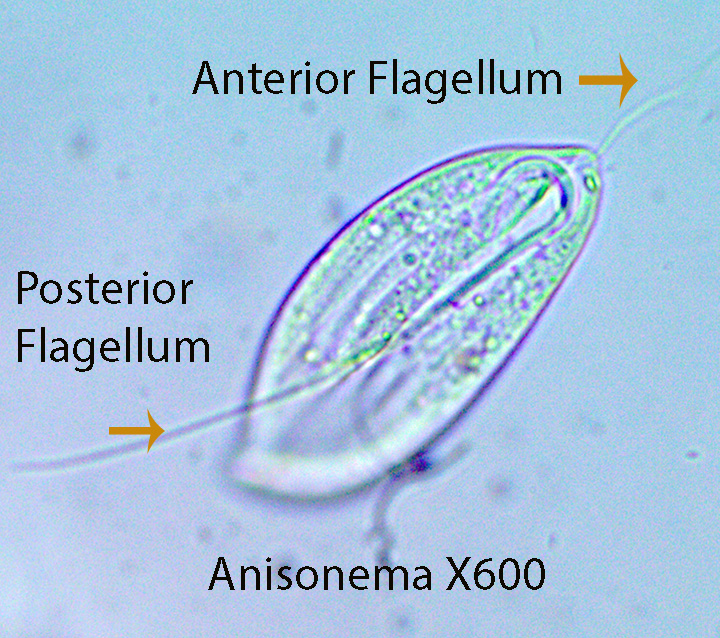
Anisonema, about 40 microns long, is flattened somewhat, from side to side. There are two visible flagella. The posterior flagellum has a broad base and is longer than the anterior flagellum; it can attach to the substratum and contract, pulling the cell body rapidly backwards with a jerky motion. The end of the flagellum often forms a hook-shaped loop. The shorter anterior flagellum waves (rotates) from side to side, pulling the cell body smoothly forward. The cell body sometimes rotates, either to the right or left, around the anterior-posterior longitudinal, central axis as they move forward. Food (Bacteria, detritus, and micro protozoans ) is taken into an anterior reservoir and incorporated into food vacuoles. (Anisonema has a posterior contractile vacuole and lacks chloroplasts.
http://vimeo.com/81154074 (Zottoli) (Anisonema)
2. Cercomonas (Cercomonadidae)
Cercomonas , about 10 microns long, has two flagella. The smaller, thinner flagellum is directed anteriorly while the thicker, longer, inactive flagellum trails behind the cell body. The posterior cell edges extend outward. The anterior flagellum is responsible for locomotion. Cercomonas is sometimes amoeboid . In the video below, two of the small flagellates are in the middle of the screen. Chloroplasts are not present.
http://vimeo.com/81154076 (Zottoli) (Cercomonas)
3. Chilomonas (Campylomonadaceae)
Chilomonas, about 30 microns long, is abundant at all stations. The cell body, round in cross-section, is inflexible. Round starch grains fill most of the cell body. They lack chloroplasts. Two flagella, one short and one long, emerge from a slight depression at the anterior end (Visible). The flagellates move from side to side propelled by the flagella. Chilomonas rotates to the left or right, on its central anterior-posterior axis as it moves forward. When the flagellate touches an obstacle, it quickly moves away and reverses direction. It may repeat the process several times before it completes the process. There is one anterior contractile vacuole.
http://vimeo.com/81155397 (Zottoli) (Chilomonas)
http://vimeo.com/81154075 (Zottoli) (Chilomonas)
http://vimeo.com/81155398 (Zottoli) (Chilomonas)
4. Euglena (Euglenaceae)
Type 1
Both types (1 and 2) of Euglena have one, thick anterior flagellum (Not visible). Both rotate on their central, anterior-posterior axis as they move forward. Both have a red stigma (Eye spot) anteriorly and both have chloroplasts. Type 1 is flexible allowing flagellates to roll up into a ball and extend the thinner anterior portion forward (Euglenoid Motion). Euglenoid motion makes it easy for Euglena to push their way through thick sediments such as mud. Chloroplasts in Type 1 are round. Type 2 is relatively inflexible and unable to roll into a ball. Also, the chloroplasts in Type 2 are elongate.
http://vimeo.com/81156203 (Zottoli) (Euglena Type 1)
http://vimeo.com/53785030 (Zottoli) (Euglena Type 1)
http://vimeo.com/81156204 (Zottoli) ( Euglena Type 2)
5. Peranema (Peranemaceae)
Peranema is a flexible, flattened, colorless (Lacks Chloroplasts) euglenoid flagellate. The animal glides through the water with a slight side to side movement. A long flagellum extends in a more or less straight line anteriorly. The flagellum tip rotates in a circle drawing the animal forward. Peranema can move to the right or left by moving the entire flagellum in the desired direction. They can also change direction by contracting the cell body into a ball and extending the anterior end and proceed along a new path. A second, much smaller flagellum (usually not visible) arises, along with the first from a “flask-shaped” clear, reservoir located at the anterior end. I observed Peranema force a small Euglena into a second reservoir, next to the reservoir containing the flagella, and form a food vacuole around it. Prey, too large to consume directly, may be taken into the reservoir and poked with an internal rod until they rupture. The released cytoplasm can then be incorporated into a food vacuole. They feed on detritus, bacteria and protozoans, etc.
https://vimeo.com/119899270 (Zottoli) (Peranema Type 1)
https://vimeo.com/119899271 (Zottoli) (Peranema Type 1 feeding)
https://vimeo.com/119899272 (Zottoli) (Peranema Type 2 feeding)
6. Petalomonas(Sphenomonadidae)
Petalomonas, about 45 microns long, has a single, long flagellum extending forward in a straight line. The anterior tip of the flagellum rotates, pulling the animal forward. The cell body of the flagellate is rigid and lacks chloroplasts. The cell has characteristic, thick, longitudinal, dorsal ridges and valleys. Small, round, green algal cells that seem to be contained in food vacuoles were observed.
http://vimeo.com/81199683 (Zottoli) (Petalomonas)
http://vimeo.com/81196215 (Zottoli) (Petalomonas)
7. Urceolus (Peranemataceae)
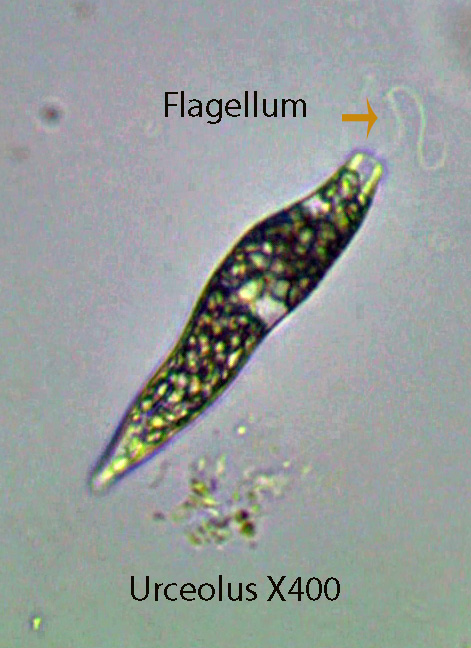
Urceolus, about 100 microns long, has a single flagellum that extends forward from the anterior end in a straight line. The tip of the flagellum rotates, drawing the animal forward. Urceolus moves to the right by shifting the flagellum to the right and swinging the posterior end to the left. It can move to the left by reversing the movement of the flagellum and body. The anterior end flares outward slightly, and the two visible rods are used to manipulate food during ingestion. Feeding was not observed. The cell body often rotates to the left or right, around the central anterior-posterior longitudinal axis.
http://vimeo.com/81196213 (Zottoli) (Urceolus)
8. Uroglenopsis (Ochromonadaceae)
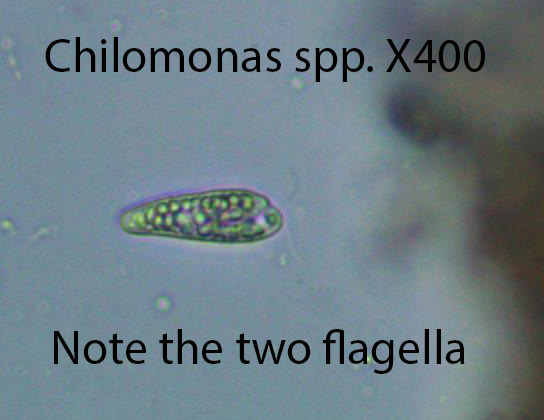
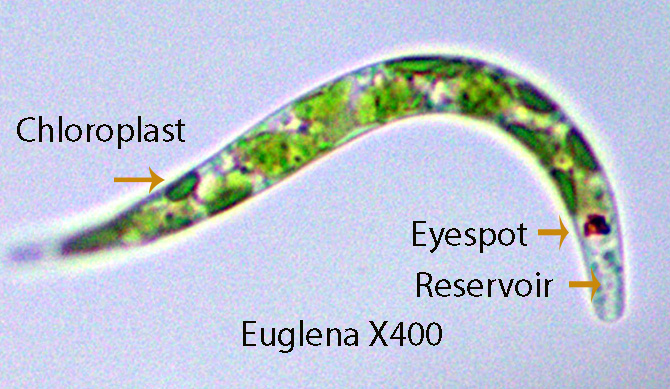
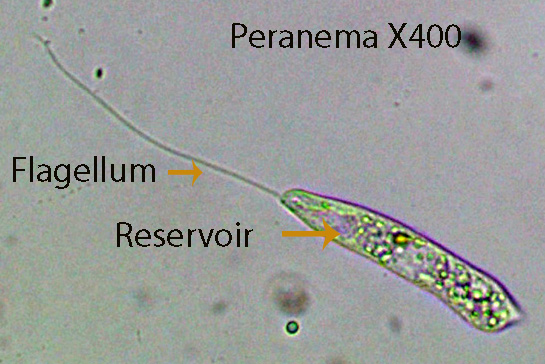
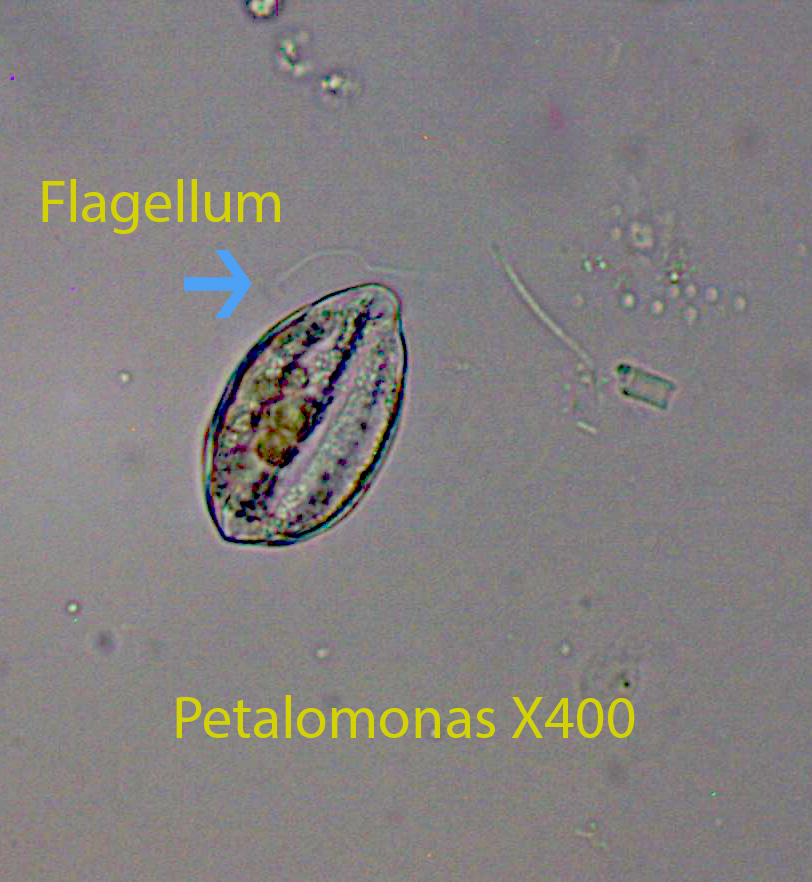
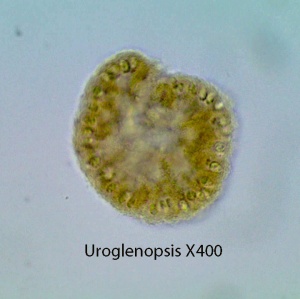
Leave a comment